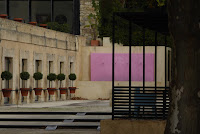
HEREWITH THE RETURN and an explanation of the seeming frugality of our journeying, insofar as we never take our breakfast in the hotel we have graced the night previous. Not for us the all-you-can-eat tussle with prepackaged jam and butter on factory built baguettes or battery farm brioche. . .
It has become a tradition, of many years standing now, to get going of a morning and dispense with the breakfast ritual (and expense), until we have gotten ourselves down or up the road somewhat. Then we begin to look out for likely bar/tabac and boulangerie adjacencies in the towns we pass or that we target to provide our p'tit dej. We don't plan these ahead, although I can report that occasionally we do fetch up again in this town or that and find ourselves in vaguely familiar surroundings . . .
Mrs Melling sniffs out the most likely (quite often the only apparent) source for our croissant needs, makes good the purchase, and then leads the way to the bar/tabac that looks like they may know how to put together a couple of grands crèmes for a suitable price. If we are lucky we get award-winning croissants with coffee of a similar standard. Sadly usually one or the other lets the show down a fraction: the coffee is not strong enough, the milk not scalding or even stone cold (and is nearly always that skimmed abomination so readily accepted by the franc and file); or the croissants seemingly not altogether au beurre, under-baked, leathery or a bit squashed.

But when, dear reader, we are in
receipt of the most exquisite confections of lightness and delicateness accompanied by très chaud battalion strength black coffee to the brim with topping of, or generous steaming jug of milk to add to taste, then a gentle smile passes over our countenances; any concern at the rather masculine domination of the bars at this time of the morning flits away and we nod and acknowledge the comings and goings of les hommes, the cheery banter between bar man (or woman) and his/her clientèle.
Such was our experience in Luçon this time where the populace was still reflecting on the overnight conflagration of a property in the town square, requiring motorists to seek passage the wrong way up the one way streets, and up and over the fat firehoses still damping down. [picture by kind permission MM enterprises]
So, of the four breakfasts taken on this return, I can announce that Luçon was the best. Lunel-Veile – coffee average (Mrs Melling says) croissants stodgy and slightly under-baked. Plouay – excellent coffee and moderately good croissants with a gratis extra. Then there was Villefranche . . . for the story there please turn to en route II
footnote: the picture of the viaduc-de-millau that graces the top of this page was our view whilst we consumed our picnic lunch, above Peyre on the first day of our 'en route' . . .
Mrs Melling sniffs out the most likely (quite often the only apparent) source for our croissant needs, makes good the purchase, and then leads the way to the bar/tabac that looks like they may know how to put together a couple of grands crèmes for a suitable price. If we are lucky we get award-winning croissants with coffee of a similar standard. Sadly usually one or the other lets the show down a fraction: the coffee is not strong enough, the milk not scalding or even stone cold (and is nearly always that skimmed abomination so readily accepted by the franc and file); or the croissants seemingly not altogether au beurre, under-baked, leathery or a bit squashed.

But when, dear reader, we are in
receipt of the most exquisite confections of lightness and delicateness accompanied by très chaud battalion strength black coffee to the brim with topping of, or generous steaming jug of milk to add to taste, then a gentle smile passes over our countenances; any concern at the rather masculine domination of the bars at this time of the morning flits away and we nod and acknowledge the comings and goings of les hommes, the cheery banter between bar man (or woman) and his/her clientèle.
Such was our experience in Luçon this time where the populace was still reflecting on the overnight conflagration of a property in the town square, requiring motorists to seek passage the wrong way up the one way streets, and up and over the fat firehoses still damping down. [picture by kind permission MM enterprises]
So, of the four breakfasts taken on this return, I can announce that Luçon was the best. Lunel-Veile – coffee average (Mrs Melling says) croissants stodgy and slightly under-baked. Plouay – excellent coffee and moderately good croissants with a gratis extra. Then there was Villefranche . . . for the story there please turn to en route II
footnote: the picture of the viaduc-de-millau that graces the top of this page was our view whilst we consumed our picnic lunch, above Peyre on the first day of our 'en route' . . .















































